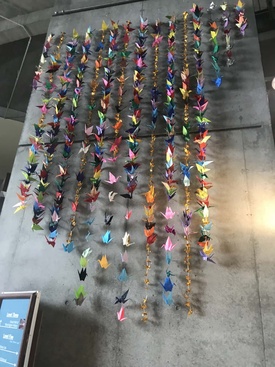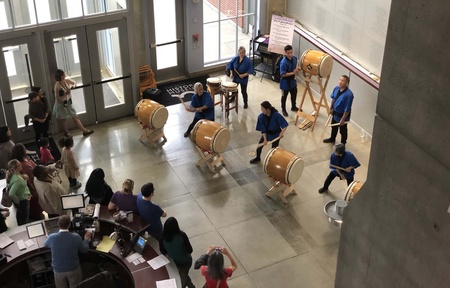On October 7th, I was asked to share a story on “what inspires me to give back” to a public event hosted by WILLO (Women’s Intergenerational Living Legacy Organization). WILLO is a Tacoma nonprofit organization devoted to sharing stories across generations and cultures, hoping to inspire the next generation of girls and women. Their events are free and occur once or twice each year. This essay is an adapted version of my talk.
It’s 2014 and I am walking up to the corner of Pacific Avenue and Commerce in downtown Tacoma, WA, just behind Elemental Pizza. It’s one of those cold, overcast September Northwest mornings. There are taiko players in blue happi coats, waving their arms around and warming up their muscles. I’m waiting for the dedication of the Tacoma’s Japanese Language School Memorial, an event that I’ve been asked to cover for Discover Nikkei. The memorial is covered up by a cloth, and it’s waiting to be unveiled.
As I wait, there are more and more groups of people that start to walk up to the plaza. By the time the event starts, there are close to 300 people at least, gathered, seated under a canopy, standing in respectful lines. There are two things I am thinking: first, where did all these Japanese American people come from?
And two: how did I live in Tacoma for ten years and not know that we had a Japantown before World War II?
* * * * *
I’d been learning about Tacoma’s Japantown in a roundabout way. For Washington State’s online encyclopedia, HistoryLink, I volunteered to write a short history of Tacoma’s Japantown—partly because I knew so little about it. While doing this research, a hand-drawn map of Tacoma’s Japantown hit me the hardest. I had learned that we’d had one, and that it was vibrant, and bustling, with close to 180+ businesses at its peak. I learned that very little remained of the neighborhood, physically, with the exception of the Whitney Memorial Methodist Church and the Tacoma Buddhist Temple. I learned that many folks didn’t come back after World War II, and that people who grew up in Tacoma didn’t even know that we had a Japantown. That’s why it was possible for me to live in Tacoma for 10 years and not know that we had had a Japantown.
After a couple of research projects on this history, Tony Gomez of the Broadway Center asked me and local historian Michael Sullivan to do a walking tour of the neighborhood. Tony was creating programming around the 75th anniversary of the signing of Executive Order 9066. Michael and I thought, sure, maybe 25 people showing up would be nice. Close to 100 people were there for our tour.
At the end of the tour, we stood in front of the Pantages Theater, exhausted but exhilarated. “You know,” Michael said, “we should do a Day of Remembrance. We should stand there at Union Station in May, where those 700+ people left, and feel that moment and that space.”
“That’s a great idea,” I said.
A couple of weeks passed. It was now early March. And I was browsing my computer, and saw a grant deadline. It would be perfect, I thought. This is exactly the kind of funding that we could use for a Day of Remembrance. It’s meant to bring people together, it’s volunteer and grassroots.
The problem was, the grant deadline was in less than 24 hours. May was less than 2 months away.
And so I thought for a little while. What would it take to do a Day of Remembrance? What would that look like? Maybe another walking tour, maybe we could have a speaker, and we could stand at Union Station like Michael said.
And then the doubts arose:
I don’t have the time to organize a big community event. I’m a freelance writer. I’m often working on multiple projects with different deadlines. I’ve got two young daughters, still in school.
I don’t have the energy to do this. An event like this takes hours and hours of work.
I don’t have the money. I would not be getting paid for this. Who would pay for space rentals, publicity, performances, food? This could mean hundreds, or even thousands of dollars.
And then there were the ethics questions. Whose story is this? My dad and his family were incarcerated during World War II. The camp story is part of my larger community story. I am Japanese American with deep historical roots in America. But I’m not Japanese American and from Tacoma. Is it my story to tell?
I did some research. The last Japanese American Day of Remembrance the City had was in the late 1990s. Why hadn’t they done one since then? Maybe they didn’t want a Day of Remembrance?
The deadline clock for the grant application kept ticking on, closer and closer.
* * * * *
So the writer side of me took over and I started to type. I could just write a draft, and I could just see how it looked. I didn’t have to turn it in.
As I typed, I thought about a few women who have influenced me.
The first one was my mother, whose actions always told me “when there’s plenty, it’s time to share.” I thought about her and my relatives, immigrants and their descendants who sacrificed so much for me to be here, and for me to be standing here with all of you.
The second one was a therapist, who I met just after I’d graduated college from UC Berkeley. I had written my honors thesis about Japanese American women writers, and I was really proud of the work I had done. The therapist, who was also Japanese American, asked me if she could read the thesis. So I gave it to her. About a month later she gave it back to me. “What did you think?,” I asked her. “It was well-written,” she said. “You did a good job. But it made me wonder, your work…” and she paused. “You talked about silence, and memory, and healing, and camp. But it made me wonder about the role of community in healing. Some of the most powerful healing I’ve experienced has happened in community.”
And this, of course, gave me pause.
The third woman is my auntie, one of the sisters to my Japanese American dad. When we were at my high school graduation party, she took me aside, and she pulled out a card in an envelope. And inside the card was a check. It was a very generous check. When I saw the amount, I was shocked. I looked up at my auntie, who said, simply, “I’ve been saving.” This is one of the aunties who gave me and my sister money from her reparations check later on—money that the US government had given Japanese Americans who were incarcerated during World War II. My sister and I didn’t qualify for it as descendants, because our father had died before the Civil Liberties Act of 1988 was signed. But that sentence—just, “I’ve been saving” had a powerful impact on me. She taught me about the concept “okagesama de, “which literally means “thanks to you, I am well.”
And ten minutes passed. So I typed as fast as I could, working on that grant application. At the very least, writing the application made me see what was possible. And I hit “send.”
Then I started to organize and figure out how to plan the event.
As luck would have it—we didn’t get the grant, due to some logistics and timing. But by then, the wheels had begun to turn and our community was showing up for us. We held the event anyway on donations and a shoestring budget, with the generous donation of space by the Washington State History Museum. About 150 people showed up. We were amazed and happy.
But now I’d like to fast-forward to the second Day of Remembrance that we held this year, once again at the Washington State History Museum. Close to two hundred people are standing in the balconies and stairs in the rotunda of the museum. There are little kids in kimonos. There are descendants of folks from the Japanese Language School. There’s a crane display folded by Japanese Americans from around the state, hanging above us. In another room, there’s a historic photo exhibit of Tacoma’s Japantown then and now. Nearly all of these things, materials, energies, space have been donated by people in our community.
And in front of us, there’s the Tacoma Fuji Taiko group, the same group that I had watched in 2014 at the language school memorial. They are playing with heart. The board president Wendy Hamai talks about the resilience of the community and the joy that comes from playing taiko. Because I am one of the writers of the most recent history on Japantown, she keeps reminding me: “Japantown is not totally lost. We’re still here.”
Taiko drumming is LOUD. You can feel the drumbeats in your heart, and you can feel them literally on your chest.
This is when I really understood the power of giving back to a community.
It’s not just about duty, or obligation to a community—these are somber words in American culture. There is sustenance, there is abundance, and there is joy in realizing that you are carried by a community. The power of giving back is that it is life-giving.
© 2018 Tamiko Nimura







